The Intel 6th Gen Skylake Review: Core i7-6700K and i5-6600K Tested
by Ian Cutress on August 5, 2015 8:00 AM ESTGenerational Tests on the i7-6700K: Gaming Benchmarks on High End GPUs
Alien: Isolation
If first person survival mixed with horror is your sort of thing, then Alien: Isolation, based off of the Alien franchise, should be an interesting title. Developed by The Creative Assembly and released in October 2014, Alien: Isolation has won numerous awards from Game Of The Year to several top 10s/25s and Best Horror titles, ratcheting up over a million sales by February 2015. Alien: Isolation uses a custom built engine which includes dynamic sound effects and should be fully multi-core enabled.
For low end graphics, we test at 720p with Ultra settings, whereas for mid and high range graphics we bump this up to 1080p, taking the average frame rate as our marker with a scripted version of the built-in benchmark.
Total War: Attila
The Total War franchise moves on to Attila, another The Creative Assembly development, and is a stand-alone strategy title set in 395AD where the main story line lets the gamer take control of the leader of the Huns in order to conquer parts of the world. Graphically the game can render hundreds/thousands of units on screen at once, all with their individual actions and can put some of the big cards to task.
For low end graphics, we test at 720p with performance settings, recording the average frame rate. With mid and high range graphics, we test at 1080p with the quality setting. In both circumstances, unlimited video memory is enabled and the in-game scripted benchmark is used.
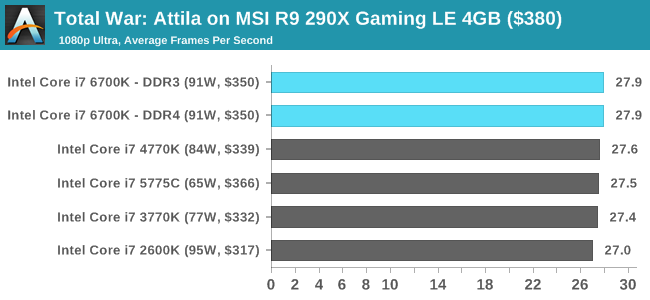
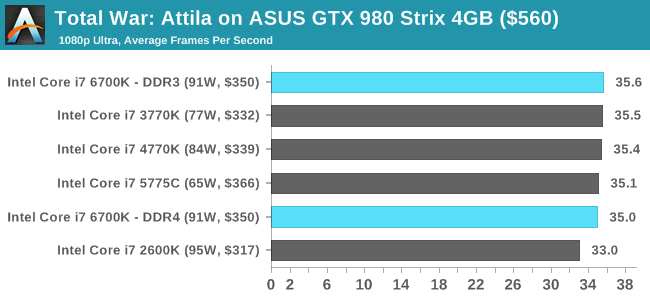
Grand Theft Auto V
The highly anticipated iteration of the Grand Theft Auto franchise finally hit the shelves on April 14th 2015, with both AMD and NVIDIA in tow to help optimize the title. GTA doesn’t provide graphical presets, but opens up the options to users and extends the boundaries by pushing even the hardest systems to the limit using Rockstar’s Advanced Game Engine. Whether the user is flying high in the mountains with long draw distances or dealing with assorted trash in the city, when cranked up to maximum it creates stunning visuals but hard work for both the CPU and the GPU.
For our test we have scripted a version of the in-game benchmark, relying only on the final part which combines a flight scene along with an in-city drive-by followed by a tanker explosion. For low end systems we test at 720p on the lowest settings, whereas mid and high end graphics play at 1080p with very high settings across the board. We record both the average frame rate and the percentage of frames under 60 FPS (16.6ms).
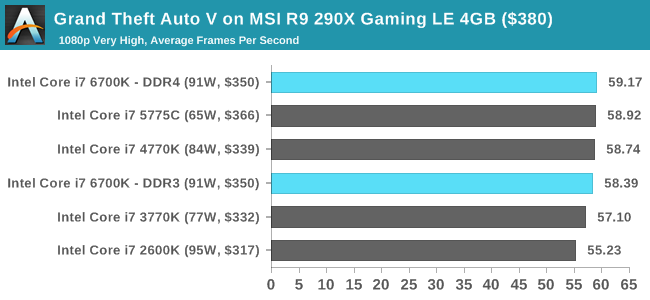
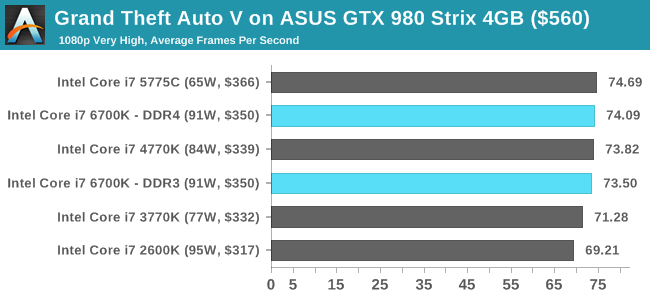
GRID: Autosport
No graphics tests are complete without some input from Codemasters and the EGO engine, which means for this round of testing we point towards GRID: Autosport, the next iteration in the GRID and racing genre. As with our previous racing testing, each update to the engine aims to add in effects, reflections, detail and realism, with Codemasters making ‘authenticity’ a main focal point for this version.
GRID’s benchmark mode is very flexible, and as a result we created a test race using a shortened version of the Red Bull Ring with twelve cars doing two laps. The car is focus starts last and is quite fast, but usually finishes second or third. For low end graphics we test at 1080p medium settings, whereas mid and high end graphics get the full 1080p maximum. Both the average and minimum frame rates are recorded.
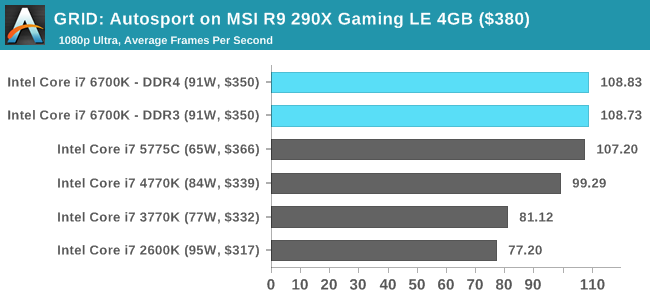

Middle-Earth: Shadow of Mordor
The final title in our testing is another battle of system performance with the open world action-adventure title, Shadow of Mordor. Produced by Monolith using the LithTech Jupiter EX engine and numerous detail add-ons, SoM goes for detail and complexity to a large extent, despite having to be cut down from the original plans. The main story itself was written by the same writer as Red Dead Redemption, and it received Zero Punctuation’s Game of The Year in 2014.
For testing purposes, SoM gives a dynamic screen resolution setting, allowing us to render at high resolutions that are then scaled down to the monitor. As a result, we get several tests using the in-game benchmark. For low end graphics we examine at 720p with low settings, whereas mid and high end graphics get 1080p Ultra. The top graphics test is also redone at 3840x2160, also with Ultra settings, and we also test two cards at 4K where possible.
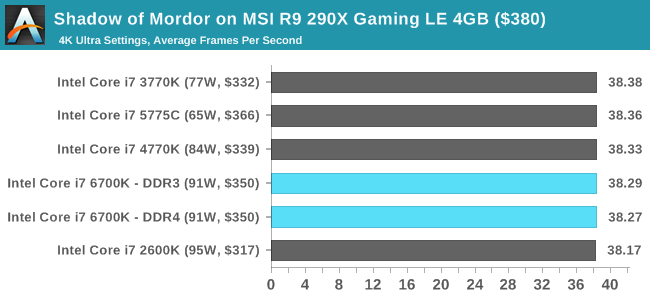
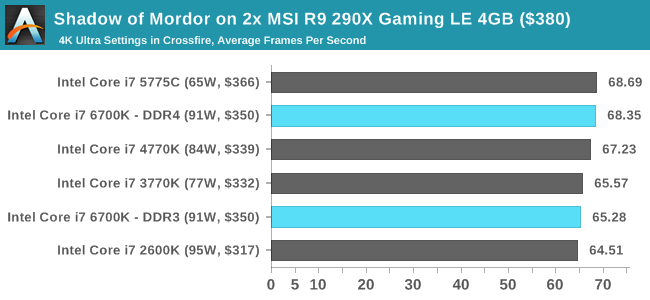
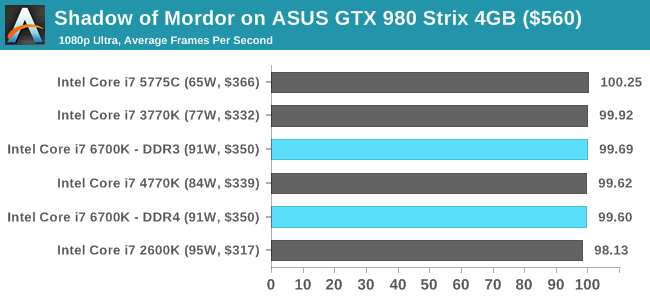
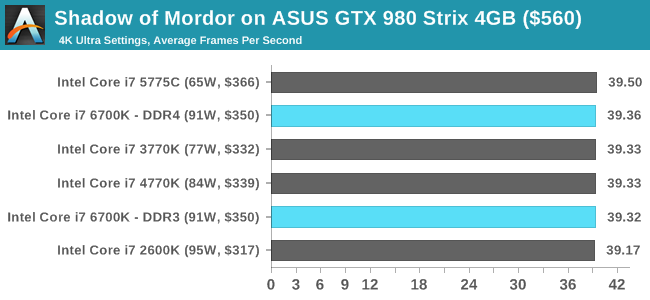



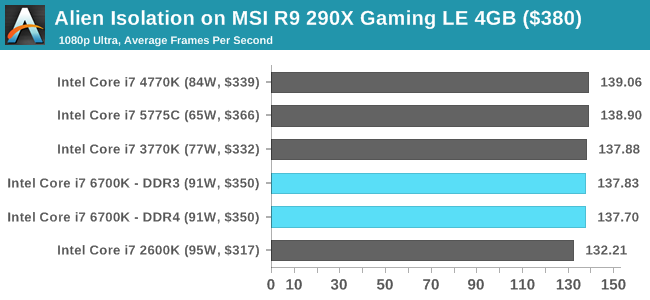
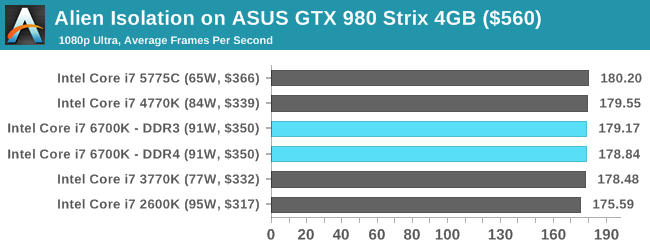












477 Comments
View All Comments
janolsen - Thursday, August 6, 2015 - link
Great review, both on details and timeliness :)Strange that graphics are slower. Why did Intel chose to downgrade the GPU from Broadwell, scrapping it makes a tiny percentage in overall CPU speed?
And discrete graphics are surprisingly is also slowed down by the new CPU/chipset.
No great reason to upgrade it seems...at least not for gamers.
HollyDOL - Thursday, August 6, 2015 - link
Few points...1. I think testing with Windows 7 is quite outdated, there seems to be benchmarks hinting there are interesting performance gains with Skylake+Windows 10... It needs to be checked out imo
2. It also seems DDR4-2133 gives quite lousy numbers. Where the difference is noticable, it looks like DDR4-3000ish seems to hit the sweet spot
3. There are decent chances performance will grow up yet with new firmware and or compiler versions. Alas, there is no doubt current numbers are such we can see.
4. Absence of decent graphics (5775C ish) seems to be like a step down for me. Either I would like to have absolutely no silicon wasted on never used graphics or have one that I can use for usual good old "DirectX 9" or older gaming without need to kick in dGPU.
5. There are definitely improvements but atm nothing that big that would make me upgrade to new platform (CPU+MOBO+RAM+GPU+NVMe SSD) to make it worth it (atm 2500K). Guess Kaby Lake and HBM2 nVidia could make it worth it.
6. Thanks Ian for exhaustive review.
Bambooz - Friday, August 7, 2015 - link
"Let's jump on the Windows 10 bandwagon and leave a solid OS that never caused problems like their so-called successors ( http://www.extremetech.com/computing/164209-window... ) behind for no good reason"mycrobe - Thursday, August 6, 2015 - link
It's interesting to speculate that Intel put so much effort into improving 14nm yield for Skylake that they scaled back on improvements to the core outside of the GPU and memory interface.Perhaps Skylake is somewhere between a tick and a tock. Call it a "tück".
Implicit in that statement is the hope that the real 14nm tock will be Kaby Lake.
versesuvius - Thursday, August 6, 2015 - link
"There’s no easy way to write this."Why? Are you having an AMD Flagship GPU moment with almighty Intel? Is that eating into the fabric of the universe as you know it?
zlandar - Thursday, August 6, 2015 - link
After looking at other reviews of Skylake I'll give props to Ian for including a Sandy Bridge processor in his review. Many of the other reviews don't include SB which is a glaring omission since many PC users still use one in their main rig.I still disagree with the assertion SB is "dead" or there is a "compelling" reason to move from SB to Skylake.
It's not that Skylake is bad or mediocre. It's just not the evolutionary jump that Sandy Bridge was from the 1st gen Core processors. When you ask people to replace a motherboard and RAM for a new processor the expectations are higher.
superjim - Friday, August 21, 2015 - link
"It's not that Skylake is bad or mediocre. It's just not the evolutionary jump that Sandy Bridge was from the 1st gen Core processors. When you ask people to replace a motherboard and RAM for a new processor the expectations are higher."This should have been on the conclusions page and sums up how I feel about SL.
eSyr - Thursday, August 6, 2015 - link
"But it is worth remembering that these tests are against a memory clock of 2133 MHz, whereas the others are at 1866 MHz. As a result, the two lines are more or less equal in terms of absolute time, as we would expect." — but latency graph is in CPU clock cycles, isn't it? And, as a consequence, these graphs should be directly comparable (and DDR4 has bigger latency in absolute time), shouldn't they?8steve8 - Thursday, August 6, 2015 - link
when can we actually buy this? the 5775c isn't even for sale yet here in the USAFruitn - Thursday, August 6, 2015 - link
We have in Denmark. Both the 5775c, 6600K, 6700K :)